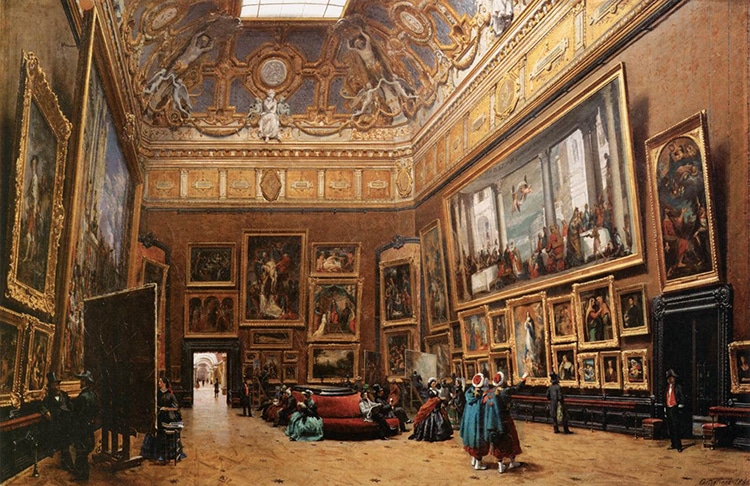
“Liberty Leading the People,”
Eugène Delacroix, 1830, after the restoration. (Photo: Wikimedia Commons)
France is known for its revolutions—the storming of the Bastille on July 14, 1789, the July Days in 1830 to overthrow a repressive king, and the return of the Bonapartes in 1848. Paris was central to these episodes in political history, so naturally this history is being broadcast as Paris takes center stage for the Olympics in summer 2024. The Louvre, France’s most prolific and famous museum, has revamped some elements of its collections to showcase French history. Among these is a newly refurbished work by Eugène Delacroix, Liberty Leading the People, which immortalizes the 1830 revolution in stunning, newly revealed color.
Delacroix was a Romanticist, painting scenes deeply impacted by Neoclassicism. Born in 1798, he grew up in post-revolutionary France as Napoleon took power and waged war across Europe. In 1815, when the young artist was a teen, Napoleon met his end and exile. He was replaced by a re-established Bourbon dynasty. In 1830, when the artist was a young man, France was once more roiling with displeasure over a series of proclamations called the July Ordinances issued by an unpopular king. These new laws limited freedoms which, since their first revolution, the French had become accustomed.
In response, the French rebelled, deposing their King Charles X after only three days. In his place was installed King Louis-Philippe, from a rival royal house, as a constitutional monarch. Delacroix was clearly moved by the 1830 July Revolution as it is called, as he painted Liberty Leading the People that year. The work features a Marianne, a woman in neo-classical garb symbolizing France, charging forward with the flag. Behind her is a pyramid of people fighting for freedom in the streets. “I have undertaken a modern subject, a barricade, and although I may not have fought for my country, at least I shall have painted for her,” the artist later wrote. “It has restored my good spirits.”
Since its almost immediate acquisition in 1831 by the Louvre, the over 8 by 10 foot painting has been a popular attraction to the millions who filter through the palace’s halls. However, years of dirt and layers of varnish have obscured Delacroix’s exceptional colors. For a long time, it was believed that Marianne wore yellow robes. However, recent restorations commenced in September 2023 have exposed the robe’s true colors—gray with gold accents. Examining the painting with modern technology has even revealed hidden elements, such as a foot near the edge and the correct order of figures. On May 2, 2024, the painting returned to view in the Mollien roo of the museum just in time for the summer Olympic tourists.
Each set of eyes can be drawn into the mass of figures in new and exciting ways. “Since its creation, almost two centuries ago, the expressive force of Delacroix’s Liberty Leading the People has never weakened, becoming the symbol of numerous liberation struggles around the world. It is one of those rare works which always ‘recharges itself’ depending on the political, social, cultural context in which it is viewed. The restoration that we have carried out has fully restored this momentum,” mused Sébastien Allard, director of the Paintings Department at the Louvre, in a statement. Delacroix would certainly be pleased that the painting remains an important part of French culture, history, and pride.
The Louvre, France’s most exceptional museum, has restored their masterpiece—Eugène Delacroix’s “Liberty Leading the People,” emblematic of revolutionary fervor.
️ Après un travail de restauration ayant nécessité le savoir-faire de dizaines d’artisans, le tableau de Delacroix « La Liberté guidant le peuple » retrouve sa place dans la salle Mollien du @MuseeLouvre.
Les 30 000 visiteurs quotidiens du musée auront à nouveau l’occasion… pic.twitter.com/GB8e0dnvVO
— Rachida Dati ن (@datirachida) April 30, 2024
The Louvre has been a museum since 1793, born itself of revolutionary fervor as the Musée Central des Arts.

Crowds view paintings in the Louvre, as depicted by
Giuseppe Castiglione in 1861, entitled “View of the Grand Salon Carré in the Louvre.” (Photo: Wikimedia Commons, Public Domain)
h/t: [Smithsonian Magazine]
Related Articles:
Louvre Museum Makes History by Appointing Its First-Ever Female President
Street Artist JR Turns the Louvre Pyramid into an Incredible Optical Illusion
Romanticism: An Art Movement That Emphasized Emotion and Turned to the Sublime
How Neoclassical Art Rejected Rococo by Reviving Classical Ideas in the 18th Century
